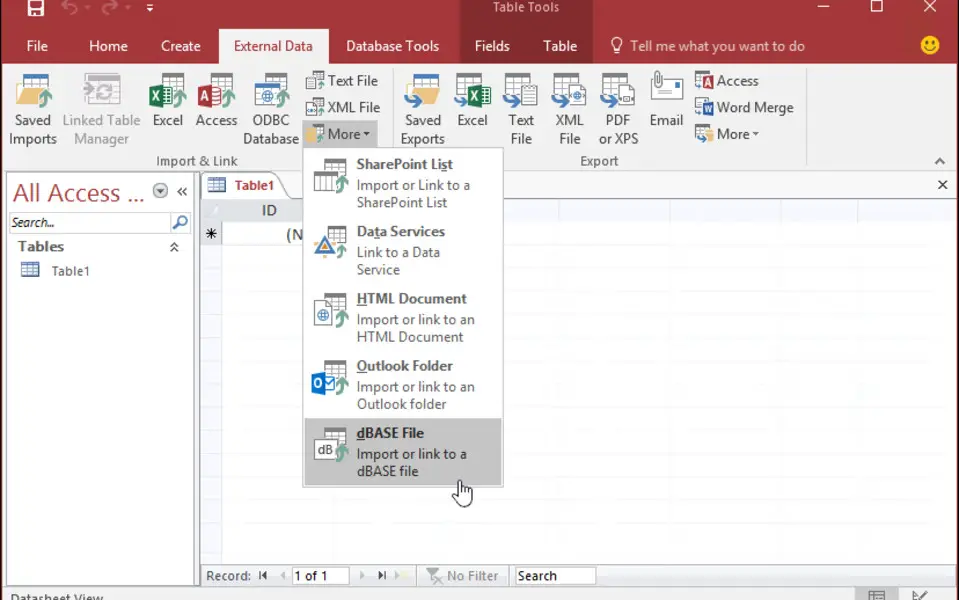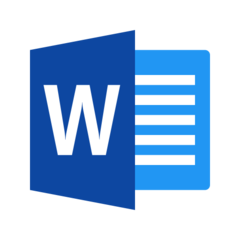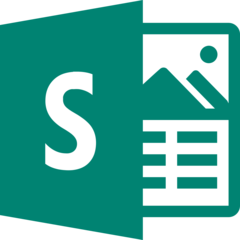Advertisement
|
There are two ways to navigate the tabs in the ribbon:
|
|||
|
To get to the ribbon, press Alt, and then, to move between tabs, use the Right Arrow and Left Arrow keys.
|
|||
|
To go directly to a tab on the ribbon, press one of the following KeyTips:
|
|||
|
You activate controls in different ways, depending upon the type of control.
|
|||
|
If the selected command is a button, to activate it, press Spacebar or Enter.
|
|||
|
If the selected command is a split button (that is, a button that opens a menu of additional options), to activate it, press Alt+Down Arrow. Tab through the options. To select the current option, press Spacebar or Enter.
|
|||
|
If the selected command is a list (such as the Font list), to open the list, press the Down Arrow key. Then, to move between items, press the Up Arrow key or the Down Arrow key.
|
|||
|
If the selected command is a gallery, to select the command, press Spacebar or Enter. Then, tab through the items.
|
|||
|
Here is the ways to move the focus by using the keyboard:
|
|
|
Open the Save As dialog box |
|
By default, Access databases display as tabbed documents. To switch to windowed documents instead, on the File tab, select Options. In the Access Options dialog box, select Current Database and, under Document Window Options, select Overlapping Windows.
|
|||
|
Note: You might need to press F6 more than once; if pressing F6 doesn't display the task pane you want, press Alt to move the focus on the ribbon and then press Ctrl+Tab to move to the task pane.
|
|||
|
Working with menus, dialog boxes, wizards, and property sheets
|
|
First letter of an option in a drop-down list: Open the list if it is closed and move to an option in the list
|
|
Note: F2 works only when the object is closed.
|
|
Note: In order to use the Ctrl+E keyboard shortcut for opening the Edit List Items dialog box, you must have an Office 365 subscription. Currently this shortcut is only available to Insiders at this time.
|
|
Note: If additional views are available, successive keystrokes move the focus to the next available view.
|
|||
|
Note: Ctrl+Period (.) does not work under all conditions with all objects.
|
|
Note: To navigate between fields and records in a subdatasheet, use the same keyboard shortcuts you use in Datasheet view.
|
|
Note: This moves the focus from the subdatasheet to the record number box.
|
|||
|
Note: Use F6 when the Tab key does not take you to the section of the screen you want.
|
|||
|
Note: For controls in a stacked layout, this switches the position of the selected control with the control directly above it, unless it is already the uppermost control in the layout.
|
|||
|
|
|||
|
Note: For controls in a stacked layout, this switches the position of the selected control with the control directly below it, unless it is already the lowermost control in the layout.
|
|||
|
|
|||
|
Note: For controls in a stacked layout, this switches the position of the selected control with the control directly above it, unless it is already the uppermost control in the layout.
|
|||
|
Note: For controls in a stacked layout, this switches the position of the selected control with the control directly below it, unless it is already the lowermost control in the layout.
|
|||
|
|
|||
|
Note: For controls in a stacked layout, this increases the width of the whole layout.
|
|||
|
Note: For controls in a stacked layout, this decreases the width of the whole layout.
|
|
Note: If used with a control that is in a layout, the entire row of the layout is resized.
|
|||
|
Note: If used with a control that is in a layout, the entire column of the layout is resized.
|
|||
|
Note: If used with a control that is in a layout, the entire row of the layout is resized.
|
|||
|
Note: If used with a control that is in a layout, the entire column of the layout is resized.
|
|
Note: If multiple items are selected, pressing Spacebar affects all selected items. Select multiple items by holding down Shift while selecting them. Toggle the selected state of a single item by holding down Ctrl while selecting it.
|
|
Note: If multiple items are selected, pressing this key affects all selected items.
|
|
You can use the standard Windows editing keys when working in the SQL pane. For example, you can use Ctrl+ Arrow keys to move between words, and the Cut, Copy, and Paste commands on the Home tab work as they normally do.
|
|
Note: In Datasheet view, Extended Selection appears in the lower-right corner of the window
|
|
Note: If the insertion point is not visible, press F2 to display it.
|
|
|
B Open the Fields tab |
||
|
|
T Open the Table tab |
||
|
|
2 Open the Add-ins tab, if present |
||
|
|
ht Turn on Move mode |
||
|
|
Exit the subdatasheet and move to the last field of the previous record in the datasheet |
||
|
|
Toggle backward between tabs when a property is selected |
||
|
|
Select the option, or select or clear the check box by the letter underlined in the option name |
||
|
|
Switch to the next or previous tab in a dialog box |
||
|
|
Exit the subform and move to the previous field in the main form or previous record |
||
|
|
Toggle forward between views when in a table, query, form, or report |
||
|
|
Toggle backward between views when in a table, query, form, or report |
||
|
|
Move to the previous field |
||
|
|
Open a combo box |
||
|
|
Enter the subdatasheet from the first field of the following record in the datasheet |
||
|
|
Exit the subdatasheet and move to the first field of the next record in the datasheet |
||
|
|
Move to the previous field |
||
|
|
Switch to the next or previous tab in a dialog box |
||
|
|
Open the selected drop-down list box |
||
|
|
Move to the next or previous option or option group |
||
|
|
With a property selected, move up one property on a tab; or if already at the top, move to the tab |
||
|
|
Toggle forward between tabs when a property is selected |
||
|
|
Move to the next or previous field in a Datasheet view |
||
|
|
Move backward through options |
||
|
|
Move between commands within a group |
||
|
|
Move the focus to commands on the ribbon |
||
|
|
Move to the next or previous command on the ribbon |
||
|
|
Move among cells |
||
|
|
Move among tables, views, and functions (and join lines, if available) |
||
|
|
Enter the subform from the following field in the main form |
||
|
|
Exit the subform and move to the next field in the master form or next record |
||
|
|
Select the previous item in the Help window |
||
|
|
Move to the preceding cell |
||
|
|
Insert a tab in a cell |
||
|
|
Insert the current time |
||
|
|
Undo typing |
||
|
|
er Open the list of choices and change the connection state |
||
|
|
Select the previous hidden text or hyperlink |
||
|
|
Move back to the previous Help topic (Back button) |
||
|
|
Move forward to the next Help topic (Forward button) |
||
|
|
Print the current Help topic (if the cursor is not in the current Help topic, press F6, and then press Ctrl+P) |
||
|
|
Insert the current date |
||
Advertisement |
|||
|
|
Open the Print dialog box from Print (for datasheets, forms, and reports) |
||
|
|
Print the current or selected object |
||
|
|
Open the Print dialog box from Print (for datasheets, forms, and reports) |
||
|
|
or F10 Select the active tab of the ribbon and activate KeyTips |
||
|
|
Select the active tab of the ribbon and activate KeyTips |
||
|
|
or F10 Show KeyTips |
||
|
|
Close the visible menu and submenu at the same time |
||
|
|
From Print Preview, open the Print dialog box |
||
|
|
Complete the wizard |
||
|
|
and then enter the search term to open the Tell me box on the ribbon |
||
|
|
Open the File page |
||
|
|
Open the folder one level above the selected folder |
||
|
|
Exit Access |
||
|
|
Open the Create tab |
||
|
|
Open the External Data tab |
||
|
|
Delete the selection or the character to the left of the insertion point |
||
|
|
Exit Access |
||
|
|
Move back to the previous Help topic (Back button) |
||
|
|
Open an existing database |
||
|
or
|
|||
|
|
Add a new record in Datasheet view or Form view |
||
|
|
Switch to the next or previous database window |
||
|
|
Move from the datasheet to the record's subdatasheet |
||
|
|
Collapse the subdatasheet |
||
|
|
Change the selection by one word to the left |
||
|
|
Change the selection by one word to the right |
||
|
|
Add a new record |
||
|
|
In a datasheet, delete the current record |
||
|
|
Insert the default value for a field |
||
|
|
Change the size of the selection by one word to the left |
||






What is your favorite Microsoft Access 2019 hotkey? Do you have any useful tips for it? Let other users know below.
1111393
500198
412256
369346
309189
279602
3 hours ago
3 hours ago
22 hours ago
22 hours ago Updated!
Yesterday Updated!
Yesterday
Latest articles